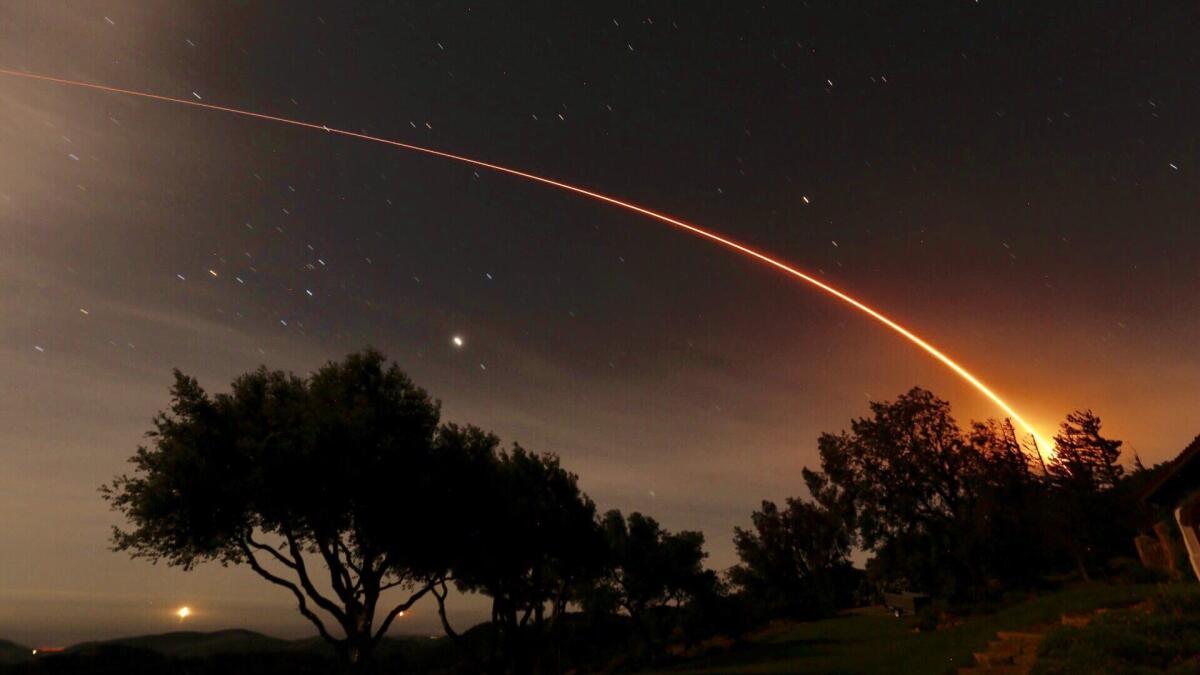NASA’s InSight spacecraft is on its way to Mars

- Share via
NASA’s InSight spacecraft is on its way to Mars after a predawn launch off California’s Central Coast.
The lander blasted off from Vandenberg Air Force Base at 4:05 a.m. Pacific time in the fog-filled darkness of early morning.
“It’s on its way,” Sue Smrekar, the mission’s deputy principal investigator based at Jet Propulsion Laboratory, said shortly after launch.
At this early hour, the rising rocket could be seen just as a spark of light rising toward the sky.
“It was thrilling,” she said.
The trip to Mars will take nearly seven months and cover roughly 301 million miles. Mission planners at JPL in La Cañada Flintridge expect the lander to touch down in Elysium Planitia in late November.
Once there, InSight will begin a two-year primary mission to study the planet’s deep interior.
Scientists with the InSight mission — its full name is Interior Exploration using Seismic Investigations, Geodesy and Heat Transport — hope that clues beneath the Martian surface will help them learn more about what the red planet was like in the past — when conditions could have been hospitable to life as we know it — and how it came to be the barren world we know today.
InSight will examine Mars in three ways.
It will place a seismometer on the ground to listen for seismic waves caused by marsquakes — the Martian analogue to earthquakes — and by falling meteorites. By studying the waves that have passed through the planet, scientists can get a better understanding of what the interior is made of.
NASA’s InSight mission will look deep into the heart of Mars for clues about its past »
InSight will also deploy a heat flow probe 16 feet underground to take the planet’s temperature. By comparing the readings from different depths, scientists can determine the temperature of the interior.
Lastly, the lander will gather clues about the size and density of the Martian core by taking detailed measurements of its oscillations. Mars’ north pole wobbles as the planet travels around the sun, and that will affect the time it takes for radio signals to travel back and forth between InSight and Earth.
Although JPL is located in Southern California, this was the first time NASA launched an interplanetary mission from the West Coast.
Usually, such missions blast off from Kennedy Space Center in Florida and head east over the Atlantic Ocean. That way, Earth’s eastward rotation can provide a natural boost.
InSight instead headed south over the Pacific aboard a powerful Atlas V-401 launch vehicle, which can ferry the spacecraft beyond the pull of Earth’s gravity all by itself.
The rocket’s trajectory took it over the Channel Islands and along the coastline of California and Baja California, Mexico. By 7:11 a.m., it was traveling at a speed of more than 11,000 mph. It took about 13 minutes for InSight to reach Earth’s orbit, NASA said.
It will land on Mars around noon on Nov. 26.
UPDATES:
7:50 a.m.: This story was updated with comments from Sue Smrekar.
7:22 a.m.: This story was updated with details on the spacecraft’s launch.
This story was originally posted May 4 at 10:00 a.m.








